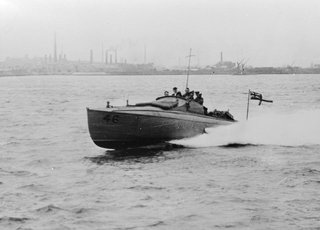In action

Although Jutland is often thought of as the only significant sea battle of the First World War, there were in fact numerous conflicts, as the Allies tried to blockade the German Navy in its home ports. with the Germans occasionally breaking out. Some of the vessels that took part in these battles still survive.
Vessels in this theme
-
CMB 4
7th-8th April 1917 -- CMB 4 takes part in an attack sinking a German destroyer and damaging another off Zeebrugge
-
Caroline
H.M.S. CAROLINE is the last remaining ship from the Battle of Jutland
-
Brandram
The motor landing craft BRANDRAM was built in 1915 as one of the 'X-lighters' to support the Gallipoli Campaign, although she was never to reach further than France.
-
Demon
DEMON was used as a gun-testing barge at Portsmouth and to bombard the Belgian coast at the end of 1914.
-
Flashing Stream
During the First World War, FLASHING STREAM served as a Naval pinnace to H.M.S. MARSHAL SOULT, which took part in the First Ostend Raid.
-
Warrior
The naval pinnace WARRIOR probably served as a coastal defence vessel during the First World War
-
Steam Cutter No. 26
STEAM CUTTER NO. 26 was on board H.M.S. FALMOUTH at the Battle of Jutland
-
Seaplane Lighter H21
During the First World War, SEAPLANE LIGHTER H21 launched fighter aircraft to attack Zeppelins
-
M33
Monitor M33 was built to support the landings at Gallipoli
-
President
PRESIDENT was one of a group of vessels commonly known as ‘Q-ships’ -- submarine decoys
-
Count Dracula
COUNT DRACULA was an admiral's barge in the German fleet at Jutland 1916
-
CMB9
CMB9 was in action at Zeebrugge, 1917
-
Caretta
Caretta was a twin-funneled Naval steam pinnace launched in 1898 at Devonport. In 1915 she was sent to the Dardanelles to cover the landing of troops on the Gallipoli beaches.
-
Spithead
The motor landing craft SPITHEAD was built in 1915 as one of the 200 X-lighters to support the Gallipoli Campaign, although she never ventured further than France.













